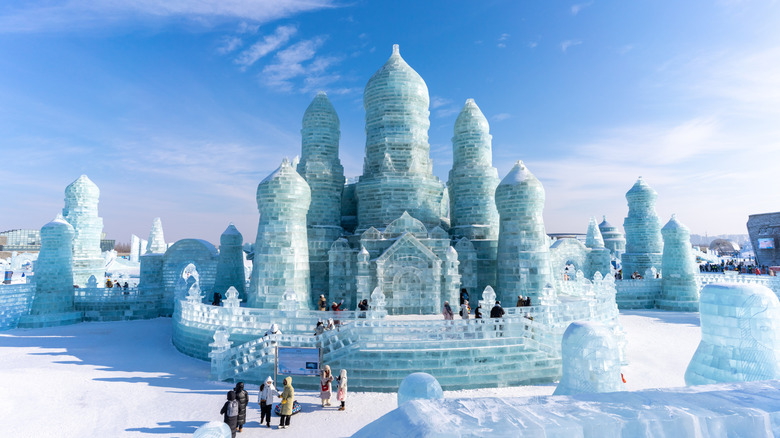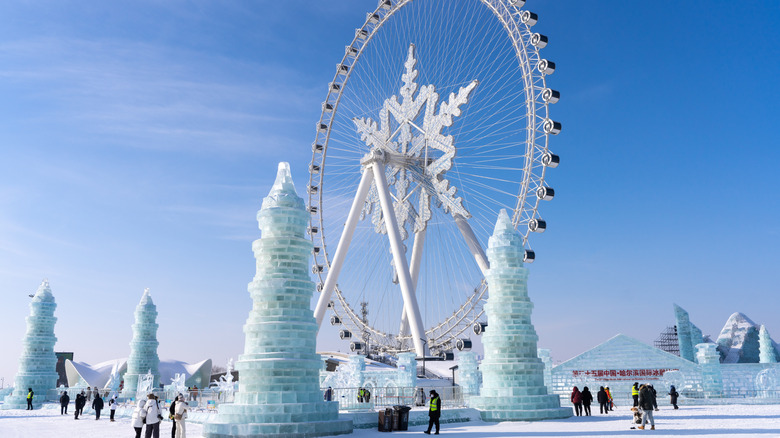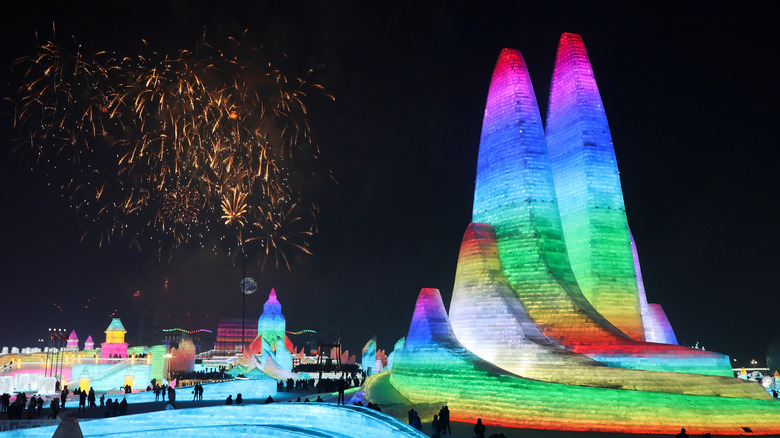The World's Largest Ice And Snow Festival Is A Thrilling World-Renowned Winter Paradise In China
Imagine stepping into a glittering wonderland of life-sized castles, intricate bridges, and towering sculptures, all carved from crystal-clear ice and pristine snow. That's exactly what awaits visitors at the Harbin International Ice and Snow Festival, a breathtaking annual spectacle that transforms Harbin, the capital of Heilongjiang Province in northern China, into a fairy tale frozen kingdom — even though it doesn't celebrate Christmas. Known as the "Ice City" and spanning over 64,000 square feet, this lesser-known Asian attraction offers a one-of-a-kind winter experience like no other.
Harbin's location near the Russian border has left an indelible mark on its architecture and culture, a fact made evident by the city's ornate, Russian-inspired buildings. As temperatures plunge well below freezing during the winter months, Harbin becomes the perfect host for the world's largest amusement park crafted entirely from ice and snow. Most of the ice used in the festival is harvested from the Songhua River. The dazzling event, often dubbed the real-life Arendelle from Disney's "Frozen," attracts millions of visitors eager to immerse themselves in its frosty splendor.
The origins of the Harbin International Ice and Snow Festival date back to 1963, when the city hosted its first ice lantern show — a modest event that resembled a garden party. It wasn't until 1985 that the festival began to take on its current form, growing exponentially over the decades. In 2001, it achieved worldwide acclaim when it was rebranded as the Harbin International Ice and Snow Sculpture Festival, coinciding with the Heilongjiang International Ski Festival. Today, the festival welcomes over 18 million visitors annually, offering a mesmerizing blend of artistry and engineering.
Harbin's frozen wonderland
The magical festival boasts three main venues that captivate visitors from around the world. The centerpiece, Harbin Ice and Snow World, often dubbed "Ice Disneyland," feels as though it has sprung straight from the pages of a fairy tale. This expansive open-air exhibition is home to the festival's most breathtaking sculptures, including 24 icy super slides, a snowflake maze, a snow ferris wheel, and the awe-inspiring Ice King Tower. As night falls, the entire venue transforms into a glowing, kaleidoscopic spectacle, where the frosty sculptures shimmer in a rainbow of vibrant hues.
Just a short distance away, Sun Island offers a contrasting but equally mesmerizing experience. Spread across vast expanses of powder-covered land, this venue hosts monumental snow sculptures painstakingly crafted by artists from around the globe. The venue showcases jaw-dropping installations that range from intricate dreamscapes to towering replicas of iconic landmarks. As the sun sets, these frosty masterpieces glow with an ethereal light, creating an enchanting aura that feels like you're stepping into a surreal dreamscape sculpted in snow and ice.
The final venue, Zhaolin Park, is the smallest, yet it's no less magical. Often referred to as an "ice world" for children, this charming park is where the young — and the young at heart — can marvel at whimsical ice lanterns and playful sculptures. Over 300 intricately carved ice figures, including animals, mythical creatures, and magical beings, light up the evening with a fairy tale-like glow as local college students and emerging sculptors bring their creations to life. Zhaolin Park also offers interactive experiences, including mini ice slides and un-carved ice blocks that are used for impromptu competitions. What makes this venue particularly special, however, is that it's the only one that is free to enter, making it an accessible winter wonderland.
A guide to the Ice and Snow Festival
As the first frost of winter settles over Harbin, the city begins its breathtaking transformation into an icy wonderland, and by mid-November, skilled artisans from around the world have flocked to the city to craft and showcase their masterpieces. The festival officially opens its gates to the public on December 21, with the grand opening ceremony taking place on January 5. The event doesn't have a fixed closing date, as the sculptures remain on display until they melt away some time in March. But don't fret if you miss it this year — this is an annual occurrence.
If you're eager to see the magic in the making, consider visiting around Christmas, when the sculptures are still being constructed and you can witness the artistry in progress. For those seeking to immerse themselves in the full celebration, the festivities peak on December 31 with a fireworks display, or on January 5 during the grand opening ceremony. However, if you're looking to avoid the largest crowds, consider traveling between January 6 and 20, or in February, after the New Year celebrations have already passed. To ensure a quieter experience, aim to visit before 2 p.m. to catch the sculptures in daylight and then return after 8 p.m. to see them bathed in the enchanting glow of the illuminated ice kingdom.
Beyond the iconic sculptures, the festival offers a wealth of thrilling activities for visitors of all ages. Ice skating, ice biking, and cultural performances bring the frosty landscape to life, while nearby ski resorts invite the more adventurous to glide down Heilongjiang's pristine, snow-covered slopes. Harbin's Ice and Snow Festival is an enchanting journey into a world where artistry meets the chill of winter, making it a bucket-list destination for any travelers seeking an unforgettable seasonal escape.


